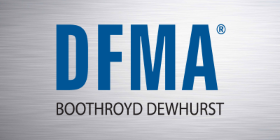Cool, Stylish and Green
In designing a new cooling display cabinet for delicatessens and supermarkets, Stockholm-based AB Electrolux, a division of UT/Carrier Corp., faced a complex challenge. The company wanted to create a product that was cost-effective and that satisfied traditional customer expectations for product appearance and performance. At the same time, Electrolux had to meet stringent targets for environmental friendliness. Reducing power consumption and materials toxicity were of foremost importance.
Design Hurdles
Commercial cooling displays present distinct challenges for environmental design. For example, the product life of cooling displays is shrinking because the marketplace demands styling updates, even when an existing system remains fully functional. Current styling and insulation methods may often contribute to the complexity of the product, increasing disassembly time at end of life.
The energy consumption of cooling displays and other refrigeration equipment is traditionally high, accounting for 60 percent of energy consumption in supermarkets. In addition, the materials used in some major components – for instance, polyester panels with PUR foam – are poor for recycling. These panels represented 18 percent of the total weight and material cost of previous cabinet designs.
Design Analyses
As a first step toward redesign, the engineering team used Boothroyd-Dewhurst DFE software to analyze an existing Electrolux display cabinet. They assessed the existing design in terms of the financial return it would yield from disassembly, disposal, reuse or recycling of components at end of life. They also assessed the environmental impact of the existing design from initial product manufacture to disposal, reuse and recycling.
The DFE software calculated the financial return at each stage of disassembly and displayed the results graphically. The team could then quickly compare the cost incurred to disassemble each item in the cabinet with the recovery value of the item. The software also calculated disposal costs for the rest of the product that would not be disassembled.
To understand the environmental impact of the cooling display cabinet, TNO utilized a value-assessment metric it had developed called MET points (Materials, Energy, Toxicity). Derived from long-used European procedures for product life-cycle assessment, the metric assigns Materials points considering the product’s impact on the exhaustion of the earth's resources. Energy points reflect the product’s impact on greenhouse gases, acidification, eutrophication and smog. Toxicity points reflect the toxic effects of the product on humans and the ecosystem. DFE software automatically calculates MET points and gives product engineers reliable data for choosing among competing “green” designs.
The software guided the designers of the Chameleon toward the following revisions:
- They replaced silicon insulating strips with more-attractive SBR foam strips that can be peeled off easily during disassembly. Overall disassembly time for the entire unit, a crucial factor for inexpensive recycling and reuse of components, was reduced by over 40 percent.
- They reduced energy consumption for the Chameleon by 11 percent, for the most part by using larger copper evaporators. The evaporators are recyclable.
- They used substitute materials to increase recyclability and provide greater ease of disassembly.
- They evaluated and implemented a strategy for modularization of subassemblies.
Improved disassembly made a policy of design reuse and revision more feasible at Electrolux. In design reuse, components and cabinetry are upgraded and replaced to meet customer performance and styling needs. In design revision, components are upgraded and replaced, but the cabinet styling remains the same.
Green Results
Even as a first generation design, the Chameleon display cabinet shows that Design for Environment can dramatically improve profitability and environmental impact. For example, Electrolux has determined that a strategy of revising the new Chameleon as parts wear out will recover 76 percent of the weight, 69 percent of the value and 88 percent of the environmental effects. Marketed under a series of brand names such as Frigidaire and Kelvinator, something cool, stylish and very green could be in supermarkets near you even now.

Electrolux tapped its European design consultant, TNO Industrial Technology (The Netherlands), to help address the challenge of green design. TNO used Design for Environment (DFE) software, developed jointly with Boothroyd Dewhurst, Inc. (Wakefield, R.I.) to simulate the disassembly and environmental impact of products at end of life. Thus was born the Chameleon, a new “green” cooling display for Electrolux.




